PVS Newsletter / Spring 2002
Message from Executive Director Elisa Yadao
Aloha! There is much excitement at the Polynesian Voyaging Society as we prepare for our next voyage, this time to the Northwestern Hawaiian Islands. This is a much different type of journey for us, as we are working with a host of wonderful partners. Our goal for the voyage is to share the richness of these kupuna islands through a voyage of exploration, education and inspiration, and with that inspiration, move all of us to take positive action in caring for all of Hawai'i's islands.
As part of our preparation for this journey, we’re hard at work on Hokule‘a, doing the most extensive repair work on the canoe since 1985. Hokule‘a should be back in the water by early summer, in time for the extensive training required for the planned voyage this fall.
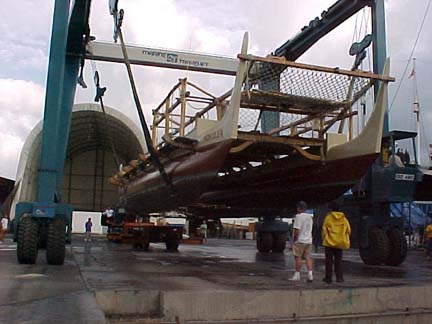
Hokule‘a lifted out of the water at Ke‘ehi Marine
All of what we're doing requires funding, and within these pages you'll find news of a new community fundraising campaign we’re launching this month. Mahalo for once again considering our request for help.
Our PVS family suffered a great loss late last year, when Myron "Pinky" Thompson passed away after a long and tiring illness. Your sympathy and support were much appreciated and a great comfort. While we miss Pinky terribly, in keeping with his vision, we are moved every day to continue our work in the spirit of malama, ensuring that Hawai'i, our special island home, be a place where the land and sea are cared for, and people and communities are healthy and safe.
Finally, this is my last letter to you as PVS Executive Director. I am leaving at the end of the month, to devote more time to caring for my family. While I am very sad to leave such a wonderful position, I am excited and proud to join the ranks of our dedicated PVS volunteers!
Message From President Nainoa Thompson
Mahalo for your continuing support of the Polynesian Voyaging Society, which makes possible all that we do. Over the last 27 years, we have sought to malama Hawai'i guided by the lessons learned on voyages that took us to places far beyond our island home. This year, we voyage in our own backyard to the Northwestern Hawaiian Islands, to share the valuable lessons to be learned there about how to care for our home here on the main Hawaiian islands.
As we anticipate the voyage ahead, we also want to say, 'Aloha' to our executive director, Elisa. I know it was a very difficult decision for Elisa to resign her official position with PVS but I respect her commitment to her family. On behalf of the Board of Directors, we extend our deepest appreciation and mahalo to Elisa for her hard work and dedication. Even as she steps back from her official position, Elisa remains committed to our cause and will continue as a volunteer. Elisa, mahalo nui loa!
Hokule‘a: The Restoration of Hawai‘i’s State Treasure
In 2000, Governor Benjamin Cayetano proclaimed Hokule‘a a Hawai'i State Treasure. Yet, to many she has always been a treasure, since her creation nearly 27 years ago. After 100,000 miles of voyage and discovery, Hokule‘a has returned to dry dock at Pier 60 at the Friends of Hokule‘a and Hawai'iloa Workshop on Sand Island. She is expected to be in dry dock for restoration until July, as PVS crewmembers and volunteers prepare the canoe for her voyage to the Northwestern Hawaiian islands this fall.
In December of 2001, Ke'ehi Marine Center, a marina and boatyard facility, which has helped PVS many times in the past, donated its time and services to haul Hbk-ule'a out of the water for dry dock. A marine survey of Hokule‘a revealed dry rot in the hull of the canoe, which is now being cleaned out to prevent the dry rot from spreading. The two front 'manu' have been removed to be patched on the inside. Modifications are also being done to keep water out of the canoe and volunteers are refurbishing the galley and captain's box where safety equipment is located. Additional storage boxes are being built for canoe supplies and new coverings are being made for sleeping quarters.

Dry rot in the hulls
"We've been getting a lot of help on weekends, however we will need much more help changing the lashing. We may even have to bring in volunteers from the neighbor islands," says volunteer Russell Aniimoto. Hokule‘a is held together with nearly 10 miles of lashing, which gives the canoe its strength.
Ka'iulani Murphy, who is helping to coordinate volunteers, says help is needed with sanding, varnishing and painting the canoe. "We have been receiving many requests from schools for students to come down and help with the restoration. Several charter schools have already begun helping on a weekly basis. We are also hoping to receive help from the larger canoe 'ohana."
Project Coordinator Bruce Blankenfeld joins fellow volunteers Russell Amimoto, Wally Froiseth, Jerry Ongies, Star Johnson, Timmy Gilliom, Jay Dowsett, Kevin San Miguel, Ann Marie Mizuno, Katherine Fuller, Ka'iulani Murphy and countless others to restore Hokule‘a to her full potential.

Timmy Gilliom chiseling out dry rot. Malama Wa‘a 2002
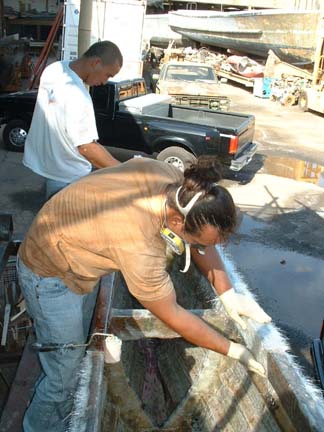
Russell and Kawai glassing in the hull
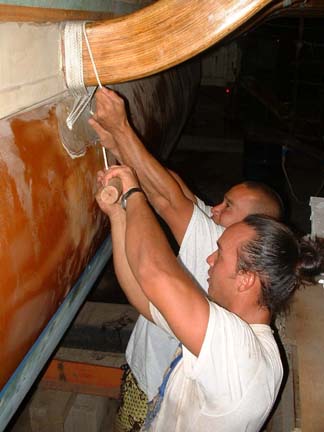
Kawai and Russ relashing a manu. Malama Wa‘a 2002
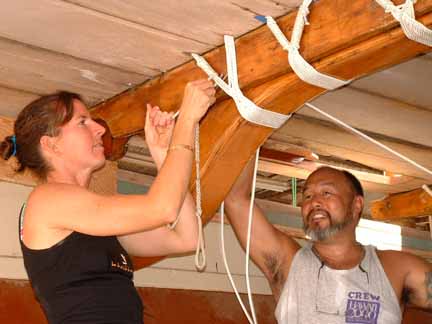
Cat and Dennis lashing down the deck
Work on the canoe is taking place Mondays through Saturdays from 8:30a.m. to 5:00 p.m., with Saturday as the major work day. The Polynesian Voyaging Society extends a big mahalo to the individuals and groups who are dedicating their time and effort to this project. Volunteers are welcome and can contact the PVS office at (808) 536-8405, fax (808) 536-1519 or email pvs@lava.net for more information.
"Hokule‘a has a lot of history and mana for everyone in Hawai'i. When the canoe sails, she is an inspiration to everyone in our islands," says Bruce Blankenfeld.
Voyage to the Kupuna Islands /Sam Low
[Sam Low will be onboard Hokule‘a to document the first leg of the NVJII voyage. He will send daily articles and photographs via satellite to be posted on the Internet, allowing the people of Hawai'i and beyond to take part in this voyage.]
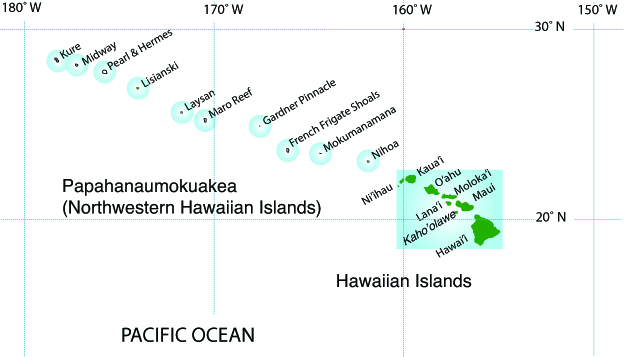
In the Fall of 2002, Hokule‘a will travel to the remote Northwestern Hawaiian Islands. Here, in a nearly pristine environment, are found 80% of our nation's coral reefs and over 7,000 marine species - half of which exist nowhere else. Hokule‘a's mission is to restore an ancient wisdom, the Hawaiian concept of MAlama - of caring for our land and sea to ensure a balance among all forms of life.
Hokule‘a is a natural vehicle for carrying this message. For the last 27 years, she has sailed more than 90,000 miles, always guided by navigators who steered without instruments or charts - sailing instead as their ancestors did - by using a world of natural signs revealed in the wind, waves and stars. Voyaging under an immense sky dome in an empty sea has inspired humility among Hokule‘a's crewmembers - an understanding of their place in the natural world. "When you voyage, you see the canoe as a tiny island surrounded by the sea," says captain and navigator Nainoa Thompson. "We have everything aboard that we need to survive as long as we marshal those resources well. Now we must look at our islands, and eventually the planet, in the same way. We must learn to be good stewards."
Ancient Polynesians fashioned canoes like Hokule‘a with stone tools. They used koa wood for the hulls, breadfruit sap and coconut husks for caulking, and coconut fiber rope for lashings. With materials from the land they fashioned a vessel to blend with the sea.
"When our ancestors went to the mountains to cut down trees they did not think they were taking the tree's life," explains navigator Bruce Blankenfeld. "They were just altering its essence, taking it from the forest and putting it into the sea, and in Hawai'i the sea and the land are tied together. Everything in the sea has a counterpart on the land because on an island the land and the sea rely on each other for life." In our rituals today we often recognize a particular kind of reef fish - life from the ocean - as equivalent to a particular taro plant - life from the land. Polynesians have always understood the inherent "oneness" of our natural world because islands are fragile places where the interaction of man and nature is clearly seen.
Many Hawaiians see the string of reefs, atolls and islands to the northwest of Kaua'i as the kupuna - the ancestors - of our home islands. Uninhabited today, these were once the abode of both humans and spirits. Necker Island, for example, is known as Mokumanamana. Mana - the Hawaiian word for spiritual power - hints at the island's special meaning among ancient Polynesians, as do the 33 shrines that dot the island.
These remote islands are also breeding grounds for over 80% of all rare Hawaiian green sea turtles - once an important food source. And they compose the Ring of Fire that extends from the nascent up-thrusting Lo'ihi, southeast of the Big Island of Hawai'i - to Kure and Midway atolls, sinking slowly in the Northwest. Taken together, they tell a 25 million year tale of geologic birth and death, the expression on our planet's face of slowly moving tectonic plates.
Once again science has proven ancient belief correct. The Northwestern Hawaiian Islands are literally the kupuna - the ancestors - of the main Hawaiian group.
Hokule‘a's voyage serves as a thread to tie together these far flung islands and atolls of the Northwestern Hawaiian group to tell many stories of ongoing research and conservation - all linked by our increasing concern for conserving life on our planet.
In the late 1800's, for example, Laysan Island was mined for eggs, birds and guano - leading to great destruction and the death of 95% of one species of seabird. Today, this remote island and its bird population are being returned to nature by the work of dedicated conservationists. On land, monk seal teams set up camp at several islands to monitor the endangered populations. Seabird counts measure the success of nesting seasons. Research on spinner dolphins has just begun at Midway. Efforts to curb the invasive weeds and insects on several of the islands are accelerating. And potential translocation of the rare Laysan Duck, endemic to small, flat Laysan Island, is in discussion. Undersea, scientists continue to explore the deep waters surrounding the islands to discover new sea life and better understand the life cycles of bottom fish. With corals in decline worldwide, marine scientists are anxious to understand these reefs before they too become victim to global warming and other environmental threats.
Hokule‘a's first mission was to prove that Polynesia was settled by intrepid seafarers who learned to blend with their ocean world in order to survive. Today, H6kftle'a sails to the theme of "navigating change" on a crowded and increasingly violent planet. "Our human societies are navigating off course," Nainoa Thompson explains. "Learning to survive on fragile islands is a microcosm for leaming to survive everywhere. Every one of us - no matter what our ethnic background or nationality - is native to this planet. As the native community of Earth we should all aspire to live in pono - in balance between all people, all living things and the resources of the Earth - our island home in an immense sea of space."
As an integral part of the NWHI voyage, the partner agencies and organizations participating in the voyage will foster and build productive, cooperative, and sustained working relationships among cultural, environmental, scientific, economic, governmental, and educational groups concerned about the future of the Hawaiian and other Pacific Islands. The Polynesian Voyaging Society is pleased to join with the following partners as we work to finalize research, education and outreach projects in conjunction with the voyage:
- Department of Land and Natural Resources, State of Hawai'i - Division of Aquatic Resources - Division of Fish and Wildlife
- Department of Education, State of Hawai'i
- Hawai'i Maritime Center
- Monte Costa Photography
- National Oceanographic and Atmospheric Administration -National Ocean Service
- Polynesian Voyaging Society
- The Nature Conservancy
- U.S. Fish and Wildlife Service, Department of the Interior
- University of Hawai'i - Center for Hawaiian Studies at Manoa - Hawai'i Institute of Marine Biology - Sea Grant - School of Ocean and Earth Sciences and Technology
- Western Pacific Regional Fishery Management Council
Hokule‘a Coming Home: Fundraiser
The NWHI voyage is about protecting and preserving the beauty of Hawai'i, by focusing on the rich cultural, historical and natural significance of these kupuna islands in a way that promotes the stewardship of all of the Hawaiian islands.
The Polynesian Voyaging Society is launching a major community fundraising effort in April 2002 called, "Hokule‘a, Coming Home" to raise raise $700,000 to support the restoration of Hokule‘a, a designated State Treasure, as well as the NWHI voyage this fall. We are asking that you, our supporters, k5kua to make this campaign a success.
Donations to the “Hokule‘a, Coming Home” fundraiser campaign can be sent to the Polynesian Voyaging Society at 191 Ala Moana Blvd., Pier 7 Honolulu, HI 96813. Checks, cash or credit cards (American Express, Visa and Mastercard) are welcomed. Contributors may also call the PVS office at 536-8405 to make donations.
By giving, you are making a commitment to the well-being of not only our island home, but to our people.
We Need Your Kokua
Some of the funding for the restoration of Hokule‘a and the NWHI expedition will come from foundations and corporate sponsors. The rest will come from our supporters and individuals from the community.
The $700,000 goal is ambitious but achievable - with the help of our supporters like you. We are asking for your kokua to make this campaign a success by inviting your friends to share in the vision and mission of the Polynesian Voyaging Society. It's easy:
- Call your friends and tell them about PVS.
- Invite them to visit our new redesigned website at www.pvs.hawaii.org.
- Call the PVS office to have a copy of this newsletter sent to your friends on your behalf.
- Mail the five postcards provided in this newsletter.
Share with your friends what you've always known and appreciated about PVS:
- The voyaging achievements of Hokule‘a and the pride those voyages instill in the people of Hawai'i.
- The lessons of caring for people and place.
- The discoveries of our past that help shape our future.
Looking at the Big Picture, Inspired through Vision: Patrick Duarte
As with any voyage, there are lessons to be learned and shared. The Northwestern Hawaiian Islands voyage message of sustainability and stewardship impact crewmembers, island dwellers and everyone who lives on Island Earth.
This is what Patrick Duarte, former Senior Vice President of Bishop Museum and expedition partner on the NWHI voyage, wants to bring to the people of Hawai'i ... students, their families, even visitors to Hawai'i. "Looking at life on an island is like looking at a microcosm of our planet. When we're talking about sustaining life on an island, we're talking about how to sustain life on Earth. This is a voyage of awareness," says Duarte, who is an important part of the educational efforts of the NWHI voyage. Duarte left the Museum last month, but is so inspired by the NWHI voyage, he's continuing to share his talent and expertise on a volunteer basis.
While crewmembers and other participants on the N"IHI voyage are making their way through land and sea, students in Hawai'i will also 'voyage' from their classrooms. Bishop Museum will offer teacher workshops that provide orientation to the N orthwe stern Hawaiian islands along with information on sustainability and stewardship, to help teachers develop lesson plans.
Bishop Museum will provide maps showing the path that Hbkfile'a will be taking. Teachers, students and anyone interested can access additional information and images of the islands from the Bishop Museum website. Duarte hopes that students will be able to communicate with Hbk-ule'a via teleconferencing calls with crewmembers.
Following the voyage, Bishop Museum hopes to implement an outreach program that will create opportunities to bring the message of stewardship and sustainability to classrooms. Crewmembers can talk about their experiences on the NMHI voyage, sharing what they have learned and how these lessons apply to everyone.
Board of Directors
President: Nainoa Thompson
Directors: Kenneth Brown, Dennis Fern, Catherine Fuller, Brickwood Galuteria, Harry Ho, Rey Jonsson, Corbett A.K. Kalama, Lilikala Kame'eleihiwa, Wiliam Ornelles, Barry Raleigh, Randall K. Schmitt, William Tam, Dr. Ben Tamura, Laura Thompson, Michael Tongg, Dr. Nathan Wong, Bob Worthington, August Yee
Consultant: Ben Finney
Executive Director: Elisa Yadao
